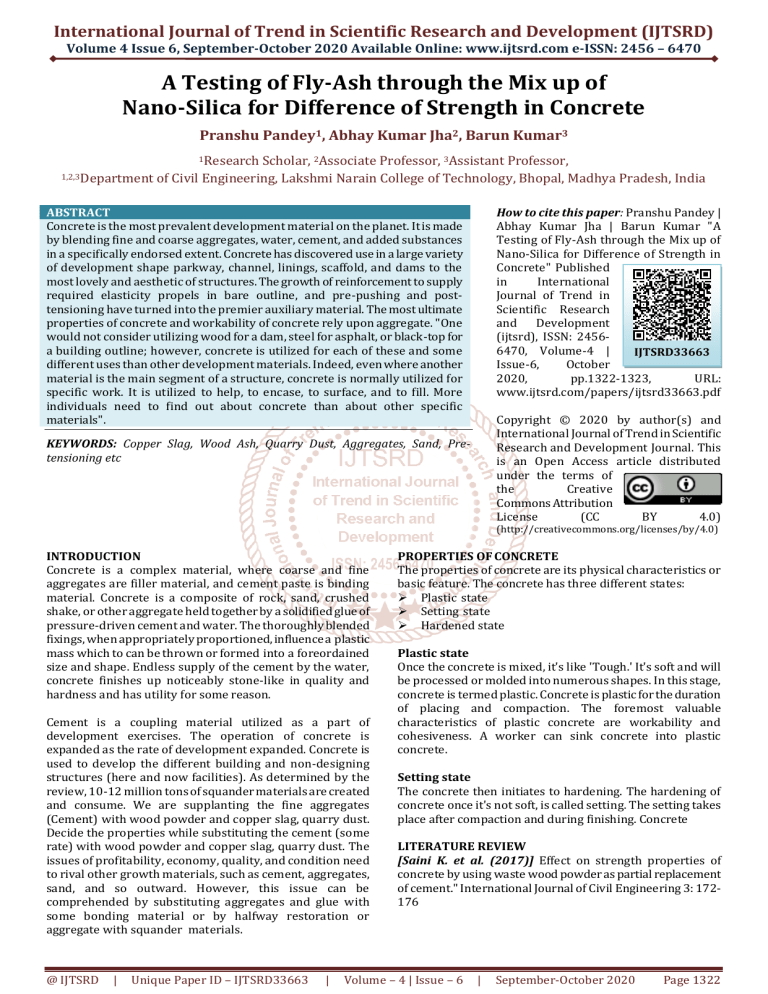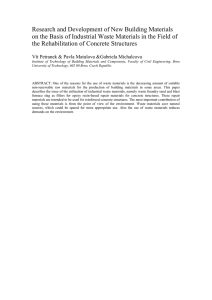
International Journal of Trend in Scientific Research and Development (IJTSRD)
Volume 4 Issue 6, September-October 2020 Available Online: www.ijtsrd.com e-ISSN: 2456 – 6470
A Testing of Fly-Ash through the Mix up of
Nano-Silica for Difference of Strength in Concrete
Pranshu Pandey1, Abhay Kumar Jha2, Barun Kumar3
1Research
Scholar, 2Associate Professor, 3Assistant Professor,
1,2,3Department of Civil Engineering, Lakshmi Narain College of Technology, Bhopal, Madhya Pradesh, India
ABSTRACT
Concrete is the most prevalent development material on the planet. It is made
by blending fine and coarse aggregates, water, cement, and added substances
in a specifically endorsed extent. Concrete has discovered use in a large variety
of development shape parkway, channel, linings, scaffold, and dams to the
most lovely and aesthetic of structures. The growth of reinforcement to supply
required elasticity propels in bare outline, and pre-pushing and posttensioning have turned into the premier auxiliary material. The most ultimate
properties of concrete and workability of concrete rely upon aggregate. "One
would not consider utilizing wood for a dam, steel for asphalt, or black-top for
a building outline; however, concrete is utilized for each of these and some
different uses than other development materials. Indeed, even where another
material is the main segment of a structure, concrete is normally utilized for
specific work. It is utilized to help, to encase, to surface, and to fill. More
individuals need to find out about concrete than about other specific
materials".
How to cite this paper: Pranshu Pandey |
Abhay Kumar Jha | Barun Kumar "A
Testing of Fly-Ash through the Mix up of
Nano-Silica for Difference of Strength in
Concrete" Published
in
International
Journal of Trend in
Scientific Research
and Development
(ijtsrd), ISSN: 24566470, Volume-4 |
IJTSRD33663
Issue-6,
October
2020,
pp.1322-1323,
URL:
www.ijtsrd.com/papers/ijtsrd33663.pdf
Copyright © 2020 by author(s) and
International Journal of Trend in Scientific
Research and Development Journal. This
is an Open Access article distributed
under the terms of
the
Creative
Commons Attribution
License
(CC
BY
4.0)
KEYWORDS: Copper Slag, Wood Ash, Quarry Dust, Aggregates, Sand, Pretensioning etc
(http://creativecommons.org/licenses/by/4.0)
INTRODUCTION
Concrete is a complex material, where coarse and fine
aggregates are filler material, and cement paste is binding
material. Concrete is a composite of rock, sand, crushed
shake, or other aggregate held together by a solidified glue of
pressure-driven cement and water. The thoroughly blended
fixings, when appropriately proportioned, influence a plastic
mass which to can be thrown or formed into a foreordained
size and shape. Endless supply of the cement by the water,
concrete finishes up noticeably stone-like in quality and
hardness and has utility for some reason.
Cement is a coupling material utilized as a part of
development exercises. The operation of concrete is
expanded as the rate of development expanded. Concrete is
used to develop the different building and non-designing
structures (here and now facilities). As determined by the
review, 10-12 million tons of squander materials are created
and consume. We are supplanting the fine aggregates
(Cement) with wood powder and copper slag, quarry dust.
Decide the properties while substituting the cement (some
rate) with wood powder and copper slag, quarry dust. The
issues of profitability, economy, quality, and condition need
to rival other growth materials, such as cement, aggregates,
sand, and so outward. However, this issue can be
comprehended by substituting aggregates and glue with
some bonding material or by halfway restoration or
aggregate with squander materials.
@ IJTSRD
|
Unique Paper ID – IJTSRD33663
|
PROPERTIES OF CONCRETE
The properties of concrete are its physical characteristics or
basic feature. The concrete has three different states:
➢ Plastic state
➢ Setting state
➢ Hardened state
Plastic state
Once the concrete is mixed, it's like 'Tough.' It's soft and will
be processed or molded into numerous shapes. In this stage,
concrete is termed plastic. Concrete is plastic for the duration
of placing and compaction. The foremost valuable
characteristics of plastic concrete are workability and
cohesiveness. A worker can sink concrete into plastic
concrete.
Setting state
The concrete then initiates to hardening. The hardening of
concrete once it's not soft, is called setting. The setting takes
place after compaction and during finishing. Concrete
LITERATURE REVIEW
[Saini K. et al. (2017)] Effect on strength properties of
concrete by using waste wood powder as partial replacement
of cement." International Journal of Civil Engineering 3: 172176
Volume – 4 | Issue – 6
|
September-October 2020
Page 1322
International Journal of Trend in Scientific Research and Development (IJTSRD) @ www.ijtsrd.com eISSN: 2456-6470
Learned about the impact on concrete quality characteristics
by utilizing squander wood powder as an incomplete
substitution of cement. This undertaking's primary point is
the use of waste materials (wooden powder) as fine
aggregates blended (expansion and fractional substitution)
with OPC to investigate these squander materials' effect on
the different concrete review limits, i.e., M30. The wooden
dust is supplanted in sand's changing extent (0%, 5%, 10%,
15%, and 20%). The undertaking is figured that the
substitution of fine aggregates by wooden powder in
concrete, for the most part, expands a definitive quality of
concrete. The accompanying focuses areas:
➢ The compressive quality, flexural quality, and split
elasticity were decreased as the wooden dust is
expanded over 25%.
➢ The substitution of 10% wooden powder with sand,
there is around 10% lessening in weight and a 3%
diminishment underway cost.
[Rohini, V.Arularasi, (2017)] Effect of Fly Ash and Quarry
Dust as a Partial Replacement of Cement and Fine Aggregate
in Concrete, International Journal of Latest Research in
Engineering and Technology, ISSN 2454-5031, 02(08), 15-33,
It has performed about the impact of quarry dust and fly ash
as a fractional replacement of cement and fine aggregate in
concrete. The concrete organization can likewise be
appropriate
METHODOLOGY
The concrete blend design is an arrangement of picking the
right parts of concrete and picking their absolute best
degrees, which would pass on as financially as could be
typical for the current circumstance, concrete that fulfills the
activity basics, i.e., the concrete having a c e r t a i n least
compressive quality the pined for workability and solidness.
The proportioning of concrete elements is represented by
the required concrete execution in two phases: the plastic
and the solidified states. The plastic concrete isn't workable;
it can't be legitimately set and compacted. The property of
workability in this manner happens to crucial significance.
The actual cost of concrete is similar to the cost of materials
needed for making a base mean quality called trademark
quality, demonstrated by the structure's planner. This relies
upon the quality control measures, yet there is more likely
than not that the quality control adds to the concrete cost.
The significant worth control level is frequently a moneyrelated exchange-off and relies upon the size and kind of
occupation. The cost of work depends upon the blend's
workability, e.g., a concrete combination of lacking
workability may realize a high value of work to get a level of
compaction with accessible apparatus.
@ IJTSRD
|
Unique Paper ID – IJTSRD33663
|
CONCLUSIONS
➢ All of the concrete containing copper slag, wood ash and
quarry dust showed normal consistency equal and more
than the control concrete. Up to 5%, 10%, and 15% of
replacement, the normal consistency was mostly
constant minor differences. At 20% replacement, the
normal consistency had shown a slight increment to
35%.
➢ Slump shows that the workability increase with the
increase in the percentages of copper slag, wood ash and
quarry dust. All investigated containing copper slag,
wood ash and quarry dust mixtures had height slump
values and acceptable workability.
➢ The compressive strength outcome represents that as
the proportion of wood ash increases for M25 grade,
compressive strength is decreased when the level of the
wood ash increment from 0% to 20%.
➢ The compressive strength outcome represents that
concrete cast with M25 grade at 7th, 14th,and 28th days
decreases with replacements of 5% to 10%, and
increments when the copper slag increment level from
15% to 20% at 7th, 14th, and 28th days.
REFERENCES
[1] Raheem A., Olasunkanmi B., and Folorunso C. (2012),
"Sawdust ash as a partial replacement for cement in
concrete." An International Journal, ISSN: 2248-962,
4(2),474-480.
[2]
Chavan, R., and Kulkarni, D. (2013), "Performance of
copper slag on strength properties as partial
replacement of fine aggregate in concrete mix design."
Int. J. Adreplacementg. Res. Studies/II/IV, EISSN2249–8974, 95, 98.
[3]
J. Ramesh Kumar, K. V. Ramana, (2013), "Use of
Copper Slag and Fly Ash in High Strength Concrete."
International Journal of Science and Research, ISSN:
2319-7064, 4(10), 777-781.
[4]
Naganur J., and Chethan B. A. (2014), "Effect of
Copper Slag as a Partial Replacement of Fine
Aggregate on the Properties of Cement Concrete."
International Journal of Research, ISSN 2348-6848,
1(8), 882-893.
[5]
Obilade I. (2014), "Use of sawdust ash as a partial
replacement for cement in concrete." IJESI, ISSN
(Online), 2319 (6734), 36-40.
[6]
Kayathri, K., Vigneshkumar, C., Rani, G., and Karthick,
K. (2014), "Effect of Copper slag, Fly Ash and Granite
Powder as a Partial Replacement in Fine aggregate."
International Journal of Innovative Research in
Science, Engineering and technology, pISSN: 2347 –
6710, 3(5), 439-443.
Volume – 4 | Issue – 6
|
September-October 2020
Page 1323



